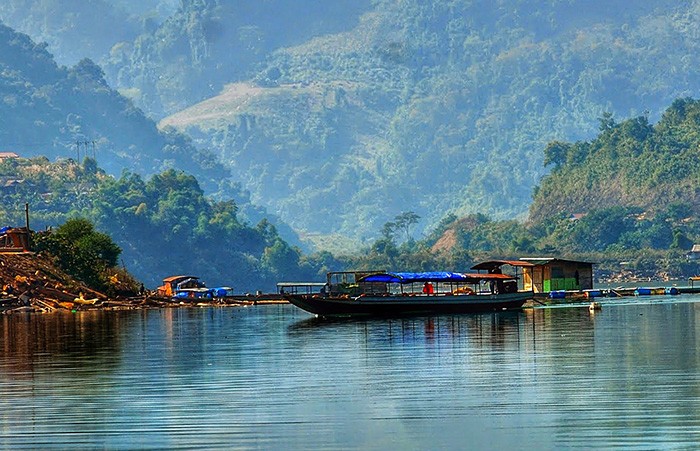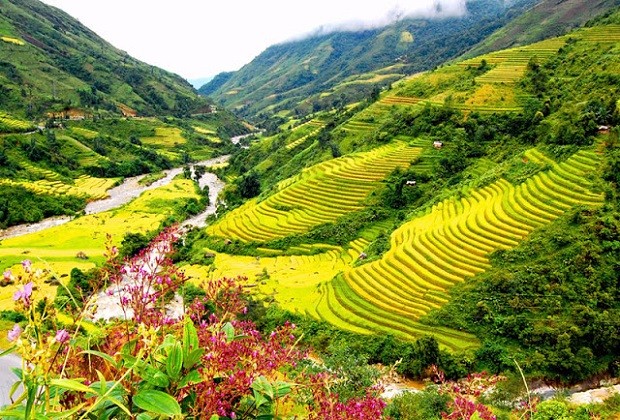
Dien Bien: A ‘gold mine’ to strive for smokeless industry development
Latest
 |
| Dien Bien is a destination that makes people feel like they are traveling in history. (Photo: dienbien.gov.vn) |
Dien Bien is known as the historic land with the “earth-shaking and resounding over 5 continents” victory.
The name of the province is given by Emperor Thieu Tri in 1841. It means a sturdy border region, which partly affirms its strategic position.
Dien Bien is a destination that makes people feel like they are traveling in history. This is because of the province’s 31 ranked historical sites, including the Special National Historical Relic Site of Dien Bien Phu Battlefield; the monument dedicated to General Vo Nguyen Giap at Muong Phang Campaign Command Headquarters; Hoang Cong Chat Temple; and the national martyrs' cemeteries of A1, Him Lam, Doc Lap (Independence), and Tong Khao.
A land full of potential
Apart from its strengths in historical tourism, the province also boasts rich potential in leisure and wellness travel.
Dien Bien Dien Bien is also endowed with many beautiful and majestic natural landscapes such as Pa Khoang Lake, the historical forest of Muong Phang, the legendary Pha Din Pass, the rocky plateau and cave system in Tua Chua District, and pure hot mineral water spots such as Pe Luong and Uva.
These resources can be considered "gold mines" for Dien Bien in developing historical-spiritual tourism products, cultural tourism combined with exploring natural landscapes, leisure and wellness travel.
There are 19 ethnic groups living together in harmony in Dien Bien. Each ethnic group has its own distinctive culture, creating an extraordinary, colorful, and attractive image for tourists.
For example, Tua Chua district has great potential for tourism development with its rocky plateau and cave system, recognized as national and provincial-level relics. It boasts a collection of 100 ancient Tuyet Shan tea trees, hundreds of years old, in Sin Chai commune, recognized as Vietnamese Heritage Trees.
As of now, the district is focusing on leveraging its existing strengths and investing in exploration tourism in order to create a special experience for tourists.
When visiting Tua Chua, tourists will be able to experience unique local cultures that have been recognized as national intangible cultural heritage: Hmong’s Khen (bamboo flute), Xoe Thai dance, Xa Phang's shoemaking and embroidery craft, and the embroidery of Hmong ethnic costumes.
Immersing oneself in the distinctive highland cultural space at Spring Festivals, market fairs, and night markets is also an incredibly interesting experience for tourists.
 |
| Muong Lay town has 2 national intangible cultural heritages, namely the Xoe Thai dance and the Kin Pang Then Festival of the white Thai people. (Photo: Trần Việt Anh) |
Meanwhile, Muong Lay town has captivated tourists with its rows of stilt houses with stone roofs nestled against the mountains, lining both sides of the Da River, creating a picturesque and charming yet unique scenery. At the confluence of three rivers, namely the Da River, the Nam Na River, and the Nam Lay stream, nine ethnic communities are living here, with the Thai ethnic group accounting for 70% of the population, mainly white Thai people.
The Thai people here still preserve their cultural heritage and unique traditional rituals, such as the Boat Racing Festival, the Kin Pang Then Festival, and ancient Thai dances. Particularly noteworthy is the tradition of building stilt houses with black stone roofs, an architectural feature that the Thai community has preserved and passed down through generations.
Muong Lay town has 2 national intangible cultural heritages, namely the Xoe Thai dance and the Kin Pang Then Festival of the white Thai people.
To develop tourism, the local authorities have been exploiting the advantages and potential of developing tourism products that deeply reflect the traditional cultural identity. Some outstanding traditional festivals of ethnic communities, such as the restored and revitalized Boat Racing Festival, have attracted tens of thousands of tourists to come and experience.
 |
| Dien Bien authorities have been exploiting the advantages and potential of developing tourism products. (Source: VGP) |
Firmly soaring and flying high
The tourism development orientation of Dien Bien province until 2025 and the vision until 2030 clearly articulate: developing tourism into the province's spearhead economic sector based on efficient exploitation of potentials and advantages, focusing on three main pillars: historical and spiritual tourism; ethnic cultural authenticity, exploring natural landscapes; resort, entertainment, and health care tourism.
In this journey, the cultural heritages of 19 ethnic groups continue to play a crucial role in tourism development, paving the way for the smokeless industry to soon become the province's spearhead.
With a clear perspective, the Provincial Planning of Dien Bien identifies that tourism development is the responsibility of the entire political system, all levels, and sectors, with strict leadership and guidance from party committees; encouraging businesses and local communities to participate in tourism development.
The province defines sustainable tourism development as the focal point, based on harnessing potentials, advantages, preserving and promoting historical and cultural values of ethnic groups, integrating development with effective management and utilization of natural resources, environmental protection, proactive adaptation to climate change, and ensuring national defense and security.
The province sets specific goals for each stage: by 2025, the tourist arrivals will exceed 1.45 million, including 300,000 international tourists, with an average annual growth rate of 15% in tourist arrivals. Total revenue from tourism activities in 2025 will surpass 2.38 trillion VND, increasing by an average of 15% annually, contributing about 10% to the province's average GRDP. The average length of stay for tourists will be 3 days.
The province aims to achieve, by 2030, over 2.65 million tourist arrivals, including 600,000 international tourists. The average annual growth rate of tourist arrivals will reach 15%. Total revenue from tourism activities in 2030 will exceed 5,000 trillion VND, increasing by over 14% annually. The average length of stay for tourists will be 3.5 days, increasing by 0.5 days compared to the period 2021-2025.
In parallel, Dien Bien aims to welcome over 7 million tourists by 2050, including over 1.2 million international tourists. Total revenue from tourism activities will reach 50,000 trillion VND, contributing over 15% to the province's average GRDP, creating direct and indirect employment for over 155,000 workers...
The Secretary of the Provincial Party Committee of Dien Bien, Tran Quoc Cuong, affirmed that with strategic vision, high spirit, and responsibility in planning, Dien Bien tourism sector promises to usher in a new era with many breakthrough development opportunities. He believes that with the potential, strengths, and distinctive advantages, combined with the determination of party committees, authorities at all levels, and the unity of ethnic groups in the area, Dien Bien tourism sector will firmly take off and soar high.

















